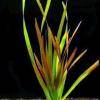Blyxa japonica
Scientific name: Blyxa japonica
Family: Hydrocharitaceae
Maximum size reached under cultivation: 5 - 15 cm (1.97 - 5.91 inch)
014
Recommended pH range: 5 - 7
Recommended water hardness: 2 - 12°dGH (35.71 - 214.29ppm)
0°C 32°F30°C 86°F
Recommended temperature range: 23 - 27 °C (73.4 - 80.6°F)
Preferred propagation method: Lateral shoots
Native to: Southeast Asia
Growth rate: Normal
Recommended substrate: Fine gravel
Lighting requirements: Bright
Ideal placement in tank: Midground
🌿 Common Name
Blyxa japonica (sometimes mistakenly called Aquarium Bamboo Grass)
🌍 Origin
Blyxa japonica is native to East Asia, particularly Japan, China, and parts of Southeast Asia. It naturally grows in shallow freshwater streams, marshes, and floodplains with soft substrates and nutrient-rich water. It favors slow-moving water with stable conditions.
💡 Lighting Requirements
Bright lighting is essential for healthy, compact growth. Under strong light, the leaves may develop beautiful reddish or golden hues. In low light, the plant tends to stretch vertically, becomes less bushy, and loses vibrant colors. Provide at least 8–10 hours of lighting daily. Supplementing with iron fertilizers can enhance its coloration and density.
💧 Water Parameters
- Temperature: 23–27 °C (73.4–80.6 °F)
- pH: 5.0–7.0
- Hardness: 2–12 °dGH (soft to moderately hard)
🌳 Growing Conditions
Blyxa japonica must be grown fully submerged. It thrives in fine gravel or nutrient-rich substrates with stable parameters. Gentle water flow improves nutrient delivery but avoid strong currents that can damage its delicate leaves. Stable CO2 levels and consistent fertilization greatly improve its vitality and appearance.
📍 Placement in Aquarium
Reaching a height of 5–15 cm (2–6 inches), this plant is ideal for the midground of aquariums. It acts as a natural transition between foreground and taller background species. Plant it in dense clusters to create lush, grassy patches and allow sufficient space for lateral spreading without overcrowding.
🌱 Propagation
Blyxa japonica reproduces via lateral shoots and runners. Small plantlets emerge near the base of mature specimens. Gently separate and replant these plantlets to expand your colony. Occasionally, it may flower under optimal conditions, but seed-based propagation is rare and unreliable in home aquariums.
⚙️ Difficulty
Moderate. While not excessively demanding, it requires stable lighting, CO2 supplementation, and nutrient-rich conditions for optimal results. Sudden changes in water chemistry or lighting can lead to leaf melt or stunted growth. Best suited for intermediate aquarists.
📝 Short Description
Blyxa japonica is a beloved aquascaping plant known for its grass-like appearance, flowing texture, and adaptability. In optimal conditions, it displays vibrant hues ranging from green to bronze and adds elegance to nature-style and Southeast Asian-themed aquariums. Although slow to moderate in growth, its natural propagation and easy trimming make it a rewarding and visually striking addition to planted tanks.

 Blyxa aubertii
Blyxa aubertii Egeria densa
Egeria densa Elodea canadensis
Elodea canadensis Vallisneria asiatica
Vallisneria asiatica Vallisneria contortionist
Vallisneria contortionist Vallisneria gigantea
Vallisneria gigantea Vallisneria rubra
Vallisneria rubra Vallisneria spiralis
Vallisneria spiralis Vallisneria torta
Vallisneria torta